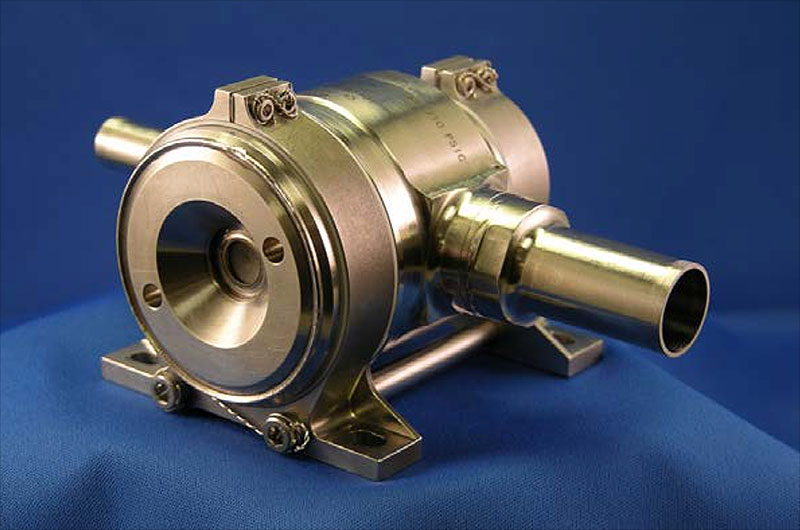From Space Plane to Sky Crane: How Part of a Space Shuttle Landed a Rover on Mars

Hardware from one of NASA's retired space shuttle orbiters played a critical role in the landing of the Curiosity rover on Mars five years ago.
Largely unknown to the public, a helium regulator that first flew multiple times into Earth orbit as part of the propulsion system for the reusable winged spacecraft was inspected, modified, tested and then re-launched as a key component of the descent stage for the six-wheeled rover that touched down on the Red Planet on Aug. 5, 2012 (PDT or Aug. 6 EDT/GMT).
"We took part of a space shuttle and put it on Mars," said Masashi Mizukami, an engineer at NASA's Jet Propulsion Laboratory (JPL) in Pasadena, Calif., in an email interview with collectSPACE. "It was an existing off-the-shelf design that could meet nearly all of the specialized [Mars Science Laboratory] MSL requirements as is." [Amazing Mars Rover Curiosity's Latest Photos]
The repurposed hardware, which brought together a team from NASA's planetary exploration and human spaceflight programs, needed to function for the rover's landing to be successful.
"On the propulsion side, this was one of the few [possible] single point failures on the mission," said John Habis, vice president of business development at VACCO Industries, which sourced the helium regulator for the shuttle program and serviced it for its reuse on MSL. "If this unit had not of worked, there was no backup."
Off the (shuttle) shelf solution
The MSL spacecraft dove into Mars' atmosphere five years ago this Saturday (Aug. 5).
To safely place Curiosity on the surface, the descent stage needed to deploy a supersonic parachute, fire eight rocket thrusters and then lower the rover using a sky crane, prior to flying itself a safe distance away to impact the ground. Everything had to work as planned and had do so without any real-time input from controllers on Earth.
Breaking space news, the latest updates on rocket launches, skywatching events and more!
"Many of us had gatherings to wait for that little beep to tell us that everything was good," Habis recalled.
For the rocket-powered portion of the descent, a pressure regulator was needed in order to precisely control the flow rate of the eight thrusters' hydrazine propellant. As a result of other program constraints, the lead time to develop such a component was limited, making an off-the-shelf solution the only real option.
"When JPL came to us, they had already exhausted one or two vendors for this application and they were not getting too far," Habis told collectSPACE. "It was while we were in discussions about other components we were doing for the [MSL] cruise stage that we discovered this opportunity was there, and they discovered what we had and what could be used."
Working across its programs and centers, NASA sourced for MSL three 750 psi helium regulators, including at least one that was extracted from the space shuttle Discovery.
Used, but like new
Although based on the same hardware, the shuttle helium regulator needed to serve a different function as part of the Mars spacecraft.
"On MSL, it provided regulated pressure to the descent stage propellant. On the space shuttle orbiter, it provided regulated purge and pneumatic actuator gas for the main engines," explained Mizukami, who was the lead author on a 2009 paper about the reuse of the regulator.
To meet its new function and the much more demanding requirements of the MSL mission, the engineers at VACCO Industries needed to inspect the heritage hardware, modify it and devise a means to test it.
"The regulator [for MSL] had more stringent requirements than the shuttle regs as far as leakage and performance," said Dave Wicke, VACCO's vice president for engineering and technology, "so they had to be rebuilt very carefully so they could meet the greater demands for a long mission to Mars, versus a shorter shuttle mission."
"We had to create an elaborate test facility to model the entire 'seven minutes of terror,'" added Habis, referencing the title that NASA use to describe MSL's dramatic entry, descent and landing (EDL).
VACCO engineers modified the shuttle hardware with new components and serviced it so it was "like new."
"It really went out of here like it was a new unit from us. The only difference was that the raw material came from the shuttle regulators," said Wicke.
Continue reading this article at collectSPACE for details on the next missions for the space shuttle heritage helium regulator.
Follow collectSPACE.com on Facebook and on Twitter at @collectSPACE. Copyright 2017 collectSPACE.com. All rights reserved.

Robert Pearlman is a space historian, journalist and the founder and editor of collectSPACE.com, a daily news publication and community devoted to space history with a particular focus on how and where space exploration intersects with pop culture. Pearlman is also a contributing writer for Space.com and co-author of "Space Stations: The Art, Science, and Reality of Working in Space” published by Smithsonian Books in 2018.
In 2009, he was inducted into the U.S. Space Camp Hall of Fame in Huntsville, Alabama. In 2021, he was honored by the American Astronautical Society with the Ordway Award for Sustained Excellence in Spaceflight History. In 2023, the National Space Club Florida Committee recognized Pearlman with the Kolcum News and Communications Award for excellence in telling the space story along the Space Coast and throughout the world.


